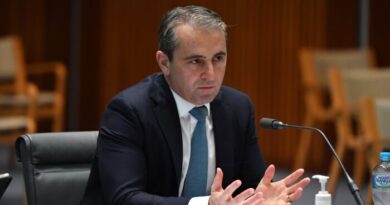Reserve Bank of Australia announces interest rate decision following May board meeting
The cash rate has been maintained at 4.35 percent once again.
The Reserve Bank of Australia (RBA) has decided to keep the cash rate target at 4.35 percent and the interest rate paid on Exchange Settlement balances at 4.25 percent.
This choice was made during a board meeting on Tuesday.
Recent data suggests that inflation, while high, is decreasing at a slower rate than anticipated, as stated in a media release by the RBA on Tuesday afternoon.
The Consumer Price Index rose by 3.6 percent in the year leading up to the March quarter, down from 4.1 percent in the previous year.
“Underlying inflation was higher than headline inflation and saw a gentler decline,” according to the statement.
“This was primarily due to services inflation, which remains elevated and is decreasing only gradually.
“The RBA noted that the increase in interest rates had helped to align aggregate demand and supply to some extent.”
However, the data also reveals ongoing excess demand in the economy, alongside robust domestic cost pressures for both labor and non-labor inputs.
The labor market conditions have softened over the past year but are still tighter than required for sustained full employment and desired inflation levels, as per the RBA.
Wages growth seems to have peaked while inflation continues to impact people’s incomes.
Outlook Remains ‘Highly Uncertain,’ Says RBA
The economic forecast is uncertain, with recent data indicating that the journey to achieve the inflation target will not be smooth, as mentioned by the RBA.
The central predictions, based on market expectations for the cash rate, imply that inflation will return to the 2 to 3 percent target range in the second half of 2025 and reach the midpoint in 2026.
Short-term projections suggest higher inflation due to recent increases in domestic petrol prices and unexpectedly high services price inflation, which is expected to decline more gradually for the rest of the year.
However, inflation is projected to decrease over 2025 and 2026.
“The persistent services inflation poses a significant uncertainty,” the RBA statement mentions.
Simultaneously, the RBA points out that household consumption growth has been sluggish due to high inflation and previous interest rate hikes impacting disposable income.
“Overall, there are uncertainties regarding the lagged effects of monetary policy, firms’ pricing decisions, and wage responses to slower economic growth in the face of excess demand and tight labor market conditions,” the RBA adds.
There is also considerable uncertainty concerning the global economic outlook, as per the RBA.
Although some overseas economies have shown improvement, geopolitical uncertainty remains high and many global commodity prices have risen.
Returning Inflation to Target a Priority
The primary objective of the board remains to bring inflation back to the target range within a reasonable timeframe, notes the RBA.
The board emphasizes the importance of being confident that inflation is moving consistently toward the target range.
“Recent data suggests that while inflation is moderating, it is happening at a slower pace than previously anticipated and it remains elevated,” the RBA states.
The board anticipates that it will take a while before inflation settles within the target range consistently and will remain alert to potential upward risks.
The optimal interest rate path to ensure inflation reaches the target within a reasonable timeframe is uncertain, and the board is open to various possibilities.
The board will rely on data and evolving risk evaluations for decision-making.
Struggling in Tight Times, Says Finance Expert
Chief economist at CreditorWatch, Anneke Thompson, believes that while goods inflation is approaching a comfortable level, services inflation is proving to be more challenging to bring down, reducing by only 0.3 percent in the March quarter.
“Despite this, the RBA understands that the cash rate has a lesser impact on services inflation compared to goods inflation, and therefore, further rate hikes would not significantly aid in accelerating services inflation into the target range,” she comments in a release.
Thompson points out that Australian Bureau of Statistics data indicates that businesses in discretionary retail, food, and drink sectors will experience the most pressure due to tight fiscal policies forcing consumers to cut back spending.
CreditorWatch’s Business Risk Index for March 2024 shows that a significant portion of invoices issued in the food and beverage services and retail trade sectors are more than 60 days overdue.
“The upcoming employment figures will likely play a crucial role in the RBA’s future cash rate decisions,” Thompson explains.
“Advocates for further monetary tightening cite persistent services inflation as a reason for raising rates, while opponents highlight declining goods inflation and stagnant retail sales as proof that monetary policy is tight enough.”
Thompson suggests that even a slight easing in the job market could signal the peak of the tightening phase, as many households and small businesses struggle financially given the high debt costs.





